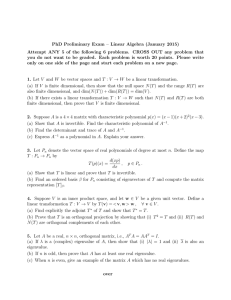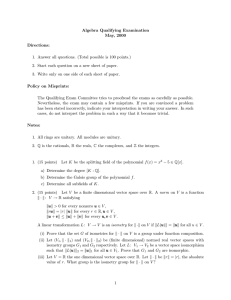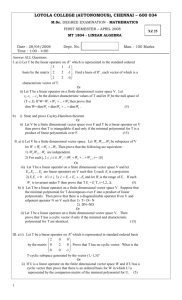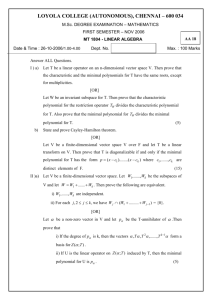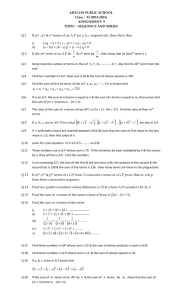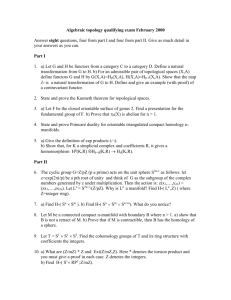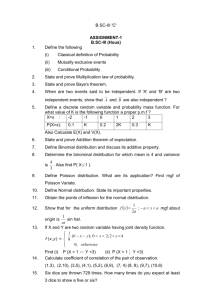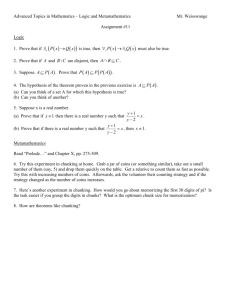MT 1810 USED
advertisement
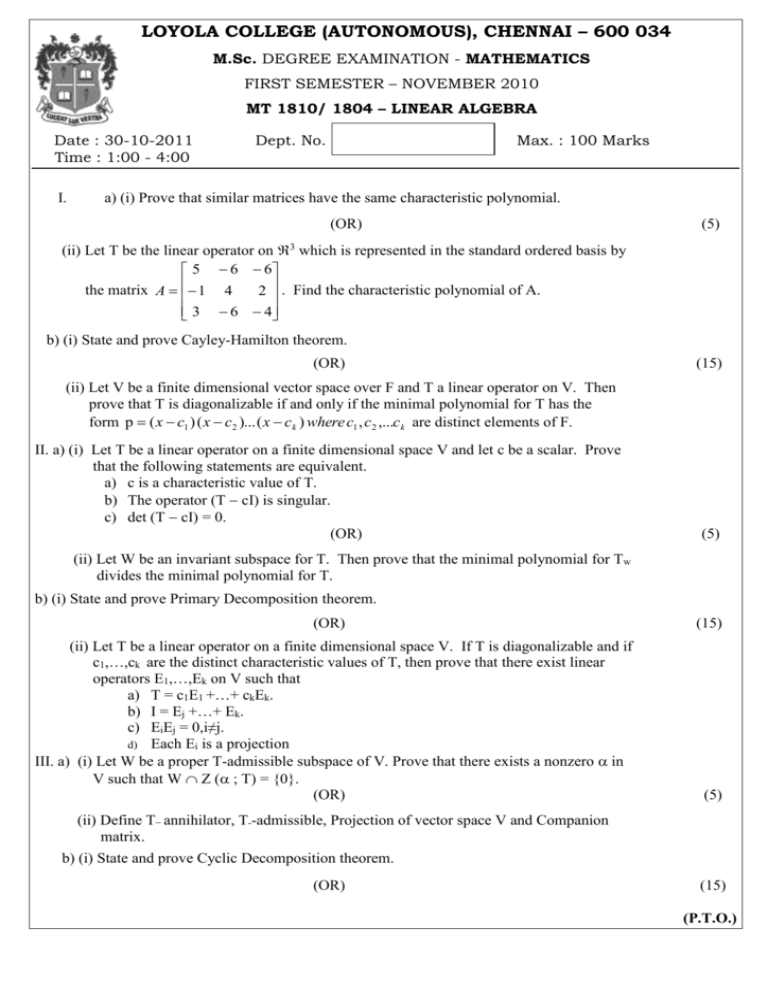
LOYOLA COLLEGE (AUTONOMOUS), CHENNAI – 600 034
M.Sc. DEGREE EXAMINATION - MATHEMATICS
FIRST SEMESTER – NOVEMBER 2010
MT 1810/ 1804 – LINEAR ALGEBRA
Date : 30-10-2011
Time : 1:00 - 4:00
I.
Dept. No.
Max. : 100 Marks
a) (i) Prove that similar matrices have the same characteristic polynomial.
(OR)
(5)
(ii) Let T be the linear operator on 3 which is represented in the standard ordered basis by
5 6 6
the matrix A 1 4
2 . Find the characteristic polynomial of A.
3 6 4
b) (i) State and prove Cayley-Hamilton theorem.
(OR)
(15)
(ii) Let V be a finite dimensional vector space over F and T a linear operator on V. Then
prove that T is diagonalizable if and only if the minimal polynomial for T has the
form p ( x c1 ) ( x c2 )... ( x ck ) where c1 , c2 ,...ck are distinct elements of F.
II. a) (i) Let T be a linear operator on a finite dimensional space V and let c be a scalar. Prove
that the following statements are equivalent.
a) c is a characteristic value of T.
b) The operator (T cI) is singular.
c) det (T cI) = 0.
(OR)
(5)
(ii) Let W be an invariant subspace for T. Then prove that the minimal polynomial for Tw
divides the minimal polynomial for T.
b) (i) State and prove Primary Decomposition theorem.
(OR)
(15)
(ii) Let T be a linear operator on a finite dimensional space V. If T is diagonalizable and if
c1,…,ck are the distinct characteristic values of T, then prove that there exist linear
operators E1,…,Ek on V such that
a) T = c1E1 +…+ ckEk.
b) I = Ej +…+ Ek.
c) EiEj = 0,i≠j.
d) Each Ei is a projection
III. a) (i) Let W be a proper T-admissible subspace of V. Prove that there exists a nonzero in
V such that W Z ( ; T) = {0}.
(OR)
(5)
(ii) Define T annihilator, T--admissible, Projection of vector space V and Companion
matrix.
b) (i) State and prove Cyclic Decomposition theorem.
(OR)
(15)
(P.T.O.)
ii) Let P be an m x m matrix with entries in the polynomial algebra F [x]. The following are
equivalent.
(i)
P is invertible
(ii)
The determinant of P is a non-zero scalar polynomial.
(iii) P is row-equivalent to the m x m identity matrix.
(iv)
P is a product of elementary matrices.
IV. a) (i) Let V be a complex vector space and f be a form on V such that f (,) is real for
every . Then prove that f is Hermitian.
(OR)
ii) Let f be the form on a finite-dimensional complex inner product space V. Then prove
that there is an orthonormal basis for V in which the matrix of f is upper-triangular.
(5)
b) (i) Let f be a form on a finite dimensional vector space V and let A be the matrix of f in an
ordered basis B. Then f is a positive form iff A = A* and the principal minors of A are all
positive.
(OR)
(15)
(ii) Let V be a finite-dimensional inner product space and f a form on V. Then show that there is a
unique linear operator T on V such that f(,) = (T) for all , in V, and the map f T is an
isomorphism of the space of forms onto L(V,V).
V. a) (i) Let V be a vector space over the field F. Define a bilinear form f on V and prove that the
function defined by f (;) = L1 () L2 () is bilinear.
(OR)
(5)
ii) Define the quadratic form q associated with a symmetric bilinear form f and prove that
1
1
f ( , ) q ( ) q ( ).
4
4
b) i) Let V be a finite dimensional vector space over the field of complex numbers. Let f be a symmetric
bilinear form on V which has rank r. Then prove that there is an ordered basis
B ={1, 2, … n} for V such that the matrix of f in the ordered basis B is diagonal and
j 1,2,..r
1,
f ( i , j )
.
jr
0,
(OR)
(15)
ii) If f is a non-zero skew-symmetric bilinear form on a finite dimensional vector space V then
prove that there exist a finite sequence of pairs of vectors, (1, β1), (2, β2),… (k, βk) with the
following properties.
a) f (j, βj) = 1 , j=1,2,,…,k.
b) f (i, j)=f(βi, βj)=f(i,βi)=0,i≠j.
c) If Wj is the two dimensional subspace spanned by j and βj, then V=W1 W2 …Wk W0
where W0 is orthogonal to all j and βj and the restriction of f to W0 is the zero form.
$$$$$$$
